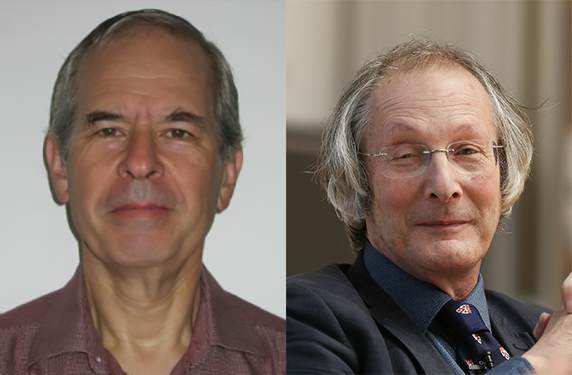CECAM-MARVEL Classics in molecular and materials modelling: Daan Frenkel and Tony Ladd
https://epfl.zoom.us/j/69679000445
Passcode: 441637
In this series, methods that have become fundamental tools in computational physics and chemistry will be presented by their originators at a level appropriate for master and graduate students. The lectures will be followed by an interview with the presenters: we’ll ask them to recall for us the period, problems, people and circumstances that accompanied the creation of milestone methods and algorithms that we now routinely use.
We hope that you will be able to join us and share with us this unusual and interesting opportunity to learn first hand from pioneers who have contributed significantly to our field and to get to know better the history and anecdotes behind work that is now recorded in books.
Program
15:00 – Introduction
15:10 – Thermodynamics of hard spheres: 1950's to 1980's (T. Ladd)
16:00 – Break
16:10 – Follow-up of the 1983 workshop (D. Frenkel)
17:00 – Interview and recollections
17:45 – End

Free-energy of solids: origins and consequences of the 1983 CECAM workshop
Thermodynamics of hard spheres: 1950's to 1980's
Tony Ladd, University of Florida
Follow-up of the 1983 workshop
Daan Frenkel, Cambridge University
Liquid-state physics was the first subject to benefit from the advent of computer simulations, because there is no reference state for a liquid and so in the early 1950's there was no "Theory of simple liquids". However, after perturbation theories were developed by Barker-Henderson and Weeks-Chandler-Andersen, the hard-sphere fluid has played a key role as a reference state for all theories of simple liquids. This has been the basis for huge theoretical advances, using simulations to determine the properties of the hard-sphere reference system.
On the other hand, solid-state physics had the harmonic solid as a reference with an exact statistical mechanics, and an analytical basis for phonon perturbation theories. In that community the need for computer simulations was only perceived by a few visionaries such as J.P. Hansen and M.L Klein. But for a crystal of hard spheres, there is no harmonic approximation, and that is why the first numerical calculations of the free-energy of solids by Hoover and Ree used hard spheres. In the years that followed, very few free-energy calculations of solids were reported; again J.P. Hansen, along with L. Verlet, was one of the few exceptions. In the 1980s' hard sphere crystals moved from being a theoretical oddity to something that could be studied experimentally in colloidal suspensions, provoking additional interest in these systems that led to an a experiment on the space shuttle mission STS-93.
At a 3-week workshop held at CECAM (then in Orsay) in 1983, the present speakers were intrigued by the problem of finding a robust and accurate way to compute the free-energy of solids. It was completely off-topic: the focus of the workshop was on novel equations of motion for molecular dynamics (constant T, p, and NEMD). But the wonderful thing about these workshops was: there were almost no talks, there was no structure (except coffee and our daily metro ride from and to the centre of Paris), and you just worked on whatever interested you.
There was an unanswered question for hard sphere systems that interested us, namely which crystal phase was the most stable: FCC or HCP. Earlier attempts by Hoover and Ree had failed to reach the required accuracy, because the difference is so small. And this stimulated us to try to do better. In the end, we also failed, but we could put much more precise bounds on the free-energy difference. In fact, it took another 15 years before the problem was resolved: FCC is more stable, in agreement with the contemporaneous results from the Columbia mission, but at considerably less expense!. The result, as such, is not so important, because the difference is so small (about 10-4 kBT) but the work set standards for the kind of accuracy that free-energy calculations should achieve, and that development continues to this day.
In our talk we will discuss the workshop, the history of the interest in hard-sphere models, and some of the follow-up studies. In the discussion, we may even tell some personal stories - if prompted.

Previous CECAM and MARVEL lectures can be found at:
https://www.materialscloud.org/learn/sections/Btmngu/marvel-events
Low-volume newsletters, targeted to the scientific and industrial communities.
Subscribe to our newsletter